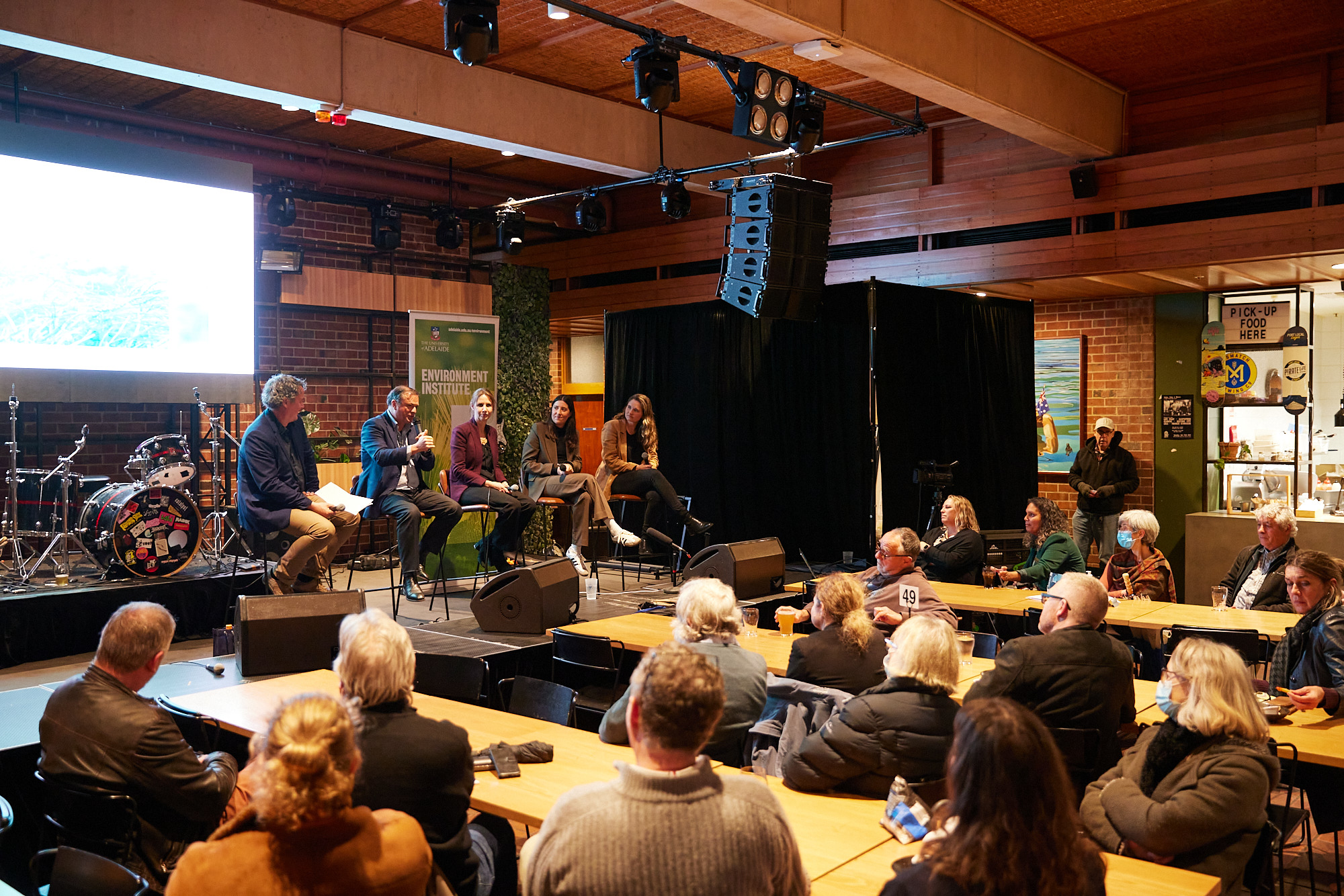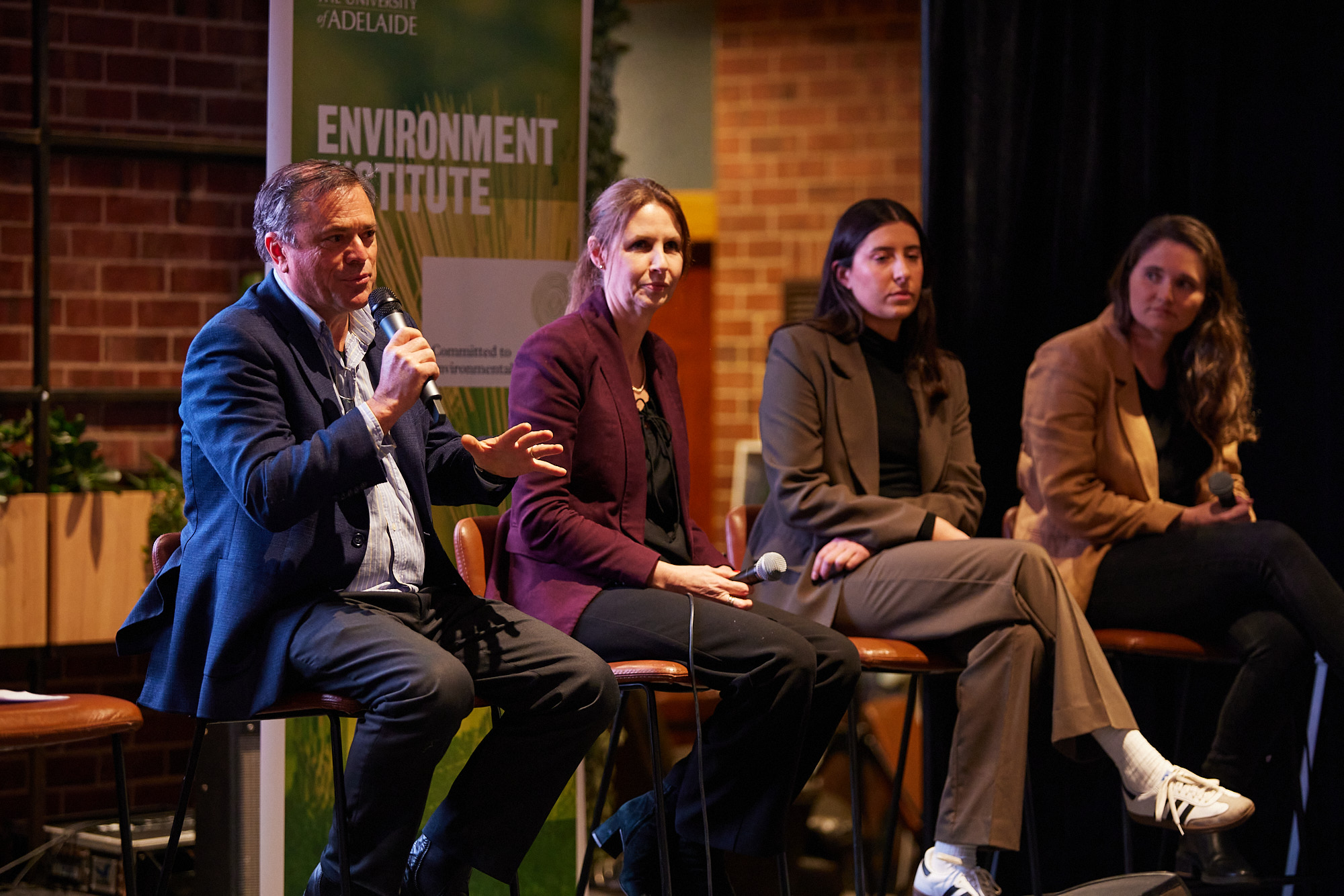VIDEO: 'Rewilding the Oceans' event
On the 22nd of August the Environment Institute hosted a panel of experts in "Rewilding the Oceans: combining marine biology & technology, public & policy" the story of a lost of the ecosystem and the journey to rebuild before it was too late.
Rewilding is becoming the primary strategy for managing our severely depleted coasts as recognised by the ‘UN Decade on Ecosystem Restoration 2021-2030’. This Q&A event discussed the integrated nature of rewilding and how linked activities and the demonstration of partnership have successfully revived the lost oyster reefs. The event was part of the University of Adelaide's Sustainability week.
[caption id="attachment_16865" align="aligncenter" width="454"]
 Photo: Audience and panel at 'Rewilding the Oceans' event.[/caption]
Photo: Audience and panel at 'Rewilding the Oceans' event.[/caption]Despite the dreary wintery weather, an enthusiastic contingent of the Environment Institute supporters, students and the general public were in attendance. Professor Andy Lowe, Interim Director of the Environment Institute, was the MC and our panel consisted of the following experts:
- Sandy Carruthers, Executive Director Strategy, Science & Corporate Services, Department for Environment & Water
- Catherine Larkin, Operations Manager & Marine Ecologist, AusOceans
- Professor Sean Connell, Marine & Freshwater Ecology Theme Lead, University of Adelaide
- Erin Pichler, PhD candidate studying marine biology
[caption id="attachment_16866" align="aligncenter" width="498"]
 Photo: 'Rewilding the Oceans' expert panel (L to R) Professor Sean Connell, Sandy Carruthers, Erin Pichler and Catherine Larkin.[/caption]
Photo: 'Rewilding the Oceans' expert panel (L to R) Professor Sean Connell, Sandy Carruthers, Erin Pichler and Catherine Larkin.[/caption]Our expert panel offered informed responses to a variety of questions from both the MC and the crowd. They discussed South Australia’s historical legacy of lost coastal ecosystems which has been plundered since the time of the early European colonists.
"(Native flat) oyster reefs must be the most degraded ecosystems in the world because they are functionally extinct. Did you know our gulfs were (once) covered in oyster reefs?" - Professor Sean Connell, Marine & Freshwater Theme Lead
They highlighted how through their collective interests and specialist knowledge we are now world leaders in restoring seagrass meadows (>5000 hectares) and reviving extinct oyster reefs (>1 kilometre-long ribbon reef). Sandy provided insights into the first of the reefs built and the decision not to build an artificial tyre reef but instead build a shellfish reef that was sustainable and create habitat for fish. She explained the community consultation that Department of Environment and Water undertook and the overwhelming community support. We heard how a relatively small investment was leveraged into a major initiative.
"For a government perspective, we wanted to ensure we had an evidence based around what we were doing so we didn't just want to spend money and assume it was going to work. We wanted to make sure we set it up with really good science to inform what we were doing." - Sandy Carrruthers, Department for Environment and Water.
There was an emphasis on how rewilding rests on combining science with technology, with Catherine Larkin bringing along an an underwater camera, an example of the inexpensive technology AusOceans builds. The camera was passed around the audience and was set to be deployed at O'Sullivans Beach to monitor turbidity. We also learnt how AusOcean's underwater speakers helped draw baby oysters (spat) to the reef.
[caption id="attachment_16864" align="aligncenter" width="431"]
 Photo: AusOcean underwater camera used for monitor the reefs.[/caption]
Photo: AusOcean underwater camera used for monitor the reefs.[/caption]Erin, a PhD student studying marine biology, relayed the beauty she had witnessed underwater in her 100+ dives on the shellfish reefs:
"in (the) summer time you have blue swimmer crabs and they pester you while you're trying to count oysters underwater ... or you'll look up and see a school of thousands of tommy ruffs circling around you, which is really beautiful."- Erin Pichler, PhD candidate
Keen to hear and learn more about:
- How badly degraded are our marine ecosystems?
- Did we completely destroy a marine species?
- How do you rebuild an oyster reef?
- Where do the baby oysters come from?
- Why do they play sounds underwater to attract baby oysters?
- Will an oyster reef fix the water quality issue?
- How do baby oysters move around the reef to find the right location?
If so, grab a cuppa, take a seat and enjoy the session
[embed]https://www.youtube.com/watch?v=DXKg-UJ964E[/embed]
To check out those cheeky blue swimmer crabs and the other beautiful marine life at the Glenelg Oyster Reef go to AusOcean's livestream highlights.
[embed]https://www.youtube.com/watch?v=ks3DZY6cFKs[/embed]

Newsletter & social media
Join us for a sensational mix of news, events and research at the Environment Institute. Find out about new initiatives and share with your friends what's happening.
